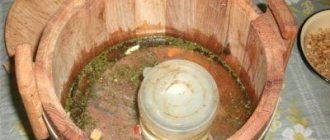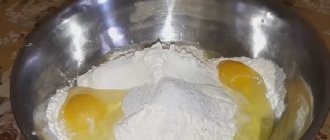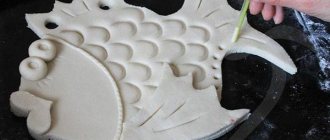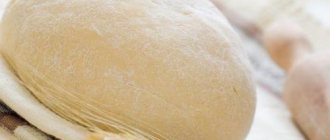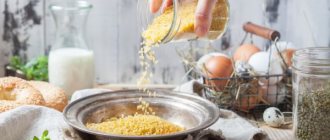Dough products require certain skills. Sometimes housewives are faced with the problem that the pie is not baked. The outside is beautiful and rosy, but the inside turns out to be damp.
It should be noted that since such a situation occurred, it means that the cooking method was violated. Sometimes the culprit is a new oven that has not yet been fully explored. However, you shouldn’t panic right away; you need to think about how to fix the pie.
What can be done to correct the situation:
- Place it at the very bottom of the oven so that it is well baked on the bottom, and then at the very top to form a crust.
- If the baked goods are still raw, lower the temperature and cover the pan with foil or parchment.
- Another option to solve the problem is to place a bowl of water on the very bottom of the oven and coat the top of the pie with milk. This will make it moist, and the baking process will go better. Instead of water, place a baking sheet with coarse salt on the lowest part so that the warm air is evenly distributed throughout the oven.
Particular attention should be paid to the oven temperature. Bakers recommend putting the dough in the oven, which is heated to 170 C, and not to 200 C.
Kefir dough
Puff pastry
If you are baking from puff pastry, then, on the contrary, the oven should be well heated. The fact is that there is a lot of oil in it, but if the oven is not heated well, the fat will simply leak out, and the dough itself will turn out wet and unbaked.
Yeast dough
Inexperienced housewives do not always make yeast pies. If you don’t know why the dough wasn’t baked, you need to remember the recipe and cooking rules:
- the top is baked, but the middle remains liquid, which means you added too much sugar;
- the mass “floats” and has absolutely no taste - lack of salt;
- the product did not rise well, and the middle remains a bit runny - lack of sugar.
What should I do to correct the situation? If you see that the baked goods are browning too quickly, reduce the temperature and cover the pan with damp paper or foil.
Do not forget that a product made with yeast requires good proofing in a warm place. If you don’t do this and put it in the oven immediately after kneading, it simply won’t have time to rise and it will be raw inside.
You should not take out the pie right away. It is necessary to give him a rest. Therefore, at first they simply open the door slightly, and after 5-10 minutes. take out the product. Rushing it may cause the baked goods to sag.
The basis
Special attention should be paid to preparing the dough. You need to knead it very carefully. If the base is made correctly, during the baking process an appetizing crust will appear on the surface of the pizza. To give the dough a pleasant aroma, it is recommended to use traditional seasonings that are mentioned in Italian recipes. These are oregano, basil, cumin, dried garlic and onion powder.
Pizza crust can be made at home or purchased at the store. Any dough before cooking is placed in the freezer. And, if the product is not allowed to thaw well, it will be difficult to knead. Therefore, before giving the base the desired shape, it should be kept at room temperature for at least five minutes. Then the dough will acquire a soft texture. It will be much easier to work with it.
Cooks do not recommend kneading the base with a rolling pin.
It will put a lot of pressure on the dough. The pizza will not have a nice fluffy texture.
Instead of a rolling pin, it is better to use the pads of your fingers and the back of your hand. The base for the dish should not be too thick or too thin (otherwise it will not support the filling and sauce).
Fillers
If you put a lot of food on the surface of the pizza, it will not cook properly. Therefore, the amount of filling should be moderate. You can experiment with different combinations of components.
For example, chunks of jerky go well with arugula, roasted red peppers go well with olives, and bacon adds saltiness to the filling.
Unlike ham, tomatoes or mushrooms, some ingredients require pre-cooking. Broccoli, cauliflower and raw sausage should be simmered before placing on the pizza surface. Otherwise, the base of the dish will be baked, but the filling will remain raw.
As for the sauce, chefs do not recommend using a store-bought product. It is better to prepare it according to your own recipe, at home.
As you know, shredded cheese is placed on the surface of the pizza. This product should be used with caution. Its excess has a bad effect on the quality of the dish.
Do you always follow the correct storage of food/medicines and their product proximity?
Yes, of course, this is very important so as not to spend money on your health later.
43.91%
Not really, because there won’t be anything like going to the toilet.
24.72%
I look at it by appearance and if I use anything after heat treatment.
31.37%
Votes: 271
Cheese
No, what could be simpler? Grate the cheese and pour it over the pizza. But no.
To make your pizza completely Italian, use mozzarella. And to make it absolutely delicious, take some other hard cheese. The fact is that mozzarella itself is a rather tasteless thing, but it stretches beautifully. Take hard cheese the way you like, the main thing is that it has a cheesy taste. Basically, grate the cheeses and mix them. Mozzarella will stretch, hard cheese will give a rich taste. Perfect!
How to bake pizza correctly?
Another common mistake is using parchment paper. It creates a barrier between the food and the container in which it is cooked. As a result, no crust appears on the surface of the pizza. Instead of parchment, cooks advise covering a frying pan or metal sheet with sunflower oil. A baking stone is also used to prepare the dish. The oven should be set to the highest temperature (500 degrees Celsius).
However, you should not overcook the pizza. Otherwise, it will become covered with a burnt crust. However, do not remove the dish from the oven too early. Culinary experts advise using the following rule: if the hostess thinks that the food is ready, she should wait five minutes before taking it out.
Special attention should be paid to preparing the dough. You need to knead it very carefully. If the base is made correctly, during the baking process an appetizing crust will appear on the surface of the pizza. To give the dough a pleasant aroma, it is recommended to use traditional seasonings that are mentioned in Italian recipes. These are oregano, basil, cumin, dried garlic and onion powder.
Sofa philosophy
I scoured the entire Internet, carefully studied all these idiotic culinary sites with advice like “well, take the dough and do something.” Then, I carefully studied the official instructions for pizza ovens. All acquaintances were interviewed. And finally, yesterday I got it - the perfect pizza. And, sighing with relief, with a piece of hot delicacy in my hands, I can share those vital secrets that allow you to make the right pizza.
1. Dough. According to all existing recipes supplied to pizza ovens, pizza dough is made exclusively with yeast. The ratio of flour and water by volume is approximately 2:1. You can use any baker's yeast. At the same time, some chefs argue that even express yeast, which can be added directly to flour, still makes sense to pre-soak it in a small amount of water to make sure that the yeast did not die during storage (I ignored this advice, my yeast turned out to be normal). After the initial kneading, olive oil is added to the dough, approximately 100 grams of oil for every kilogram of flour. After adding oil, knead the dough further. You cannot add oil directly to the flour - it will create a film that will prevent the yeast from developing. Replacing olive oil with sunflower oil in original recipes is not allowed (experiment yourself if you wish). Total composition of the dough, according to the recipe of the Rialto conveyor oven in terms of normal volumes: Flour 0.5 kg, water 225 ml, yeast - according to the yeast recipe (regular pressed yeast requires 20 g), olive oil - 50 g, salt - 10 gr. Fans of slightly sweetened dough (I am one of them) can add 5-10 grams. Sahara. When rolling out pizza. Determine the thickness of the circle yourself. For me it turns out equally tasty with both thick and thin dough. When the filling is placed, the excess dough sticking out at the edges is pinched. 2. Stuffing. With filling - whatever you like, that's what pizza is for. The only caveat is - don’t throw everything you have in the refrigerator onto an unfortunate circle of dough. The main mistake that all beginners make is to put on a wild amount of filling, taking revenge for the fact that there is so little of this filling in pizzerias. Like, “Now I’ll show everyone how generous pizza should be.” If you have too thick a layer of topping, the pizza won’t bake—the cheese on top will already dry out and shrink, and the dough won’t even set yet. The pizza should be thin. If you have a lot of filling, make several pizzas. It's much more fun that way. The dough, placed in a mold, is greased with tomato sauce. You can invent this sauce yourself, you can run around your friends and demand to give up the secret, but if you just want good pizza without any problems, then use ordinary high-quality tomato paste as a sauce, because what you should get as a result of experimenting with the sauce - and there is that same tomato paste. About two teaspoons per circle with a diameter of 30 cm is enough to gently spread the sauce over the entire surface. Cheese must be placed on pizza twice. The first layer of cheese goes immediately on top of the sauce, then the filling is placed, and the second layer of cheese is distributed on top of the filling. The first layer will be protected by the filling from drying out, as a result of which the cheese in the pizza will always stretch. You can divide the cheese in half, you can lay it 60%:40%. By the way, in all recipes (except for the “4 cheeses” recipe), manufacturers recommend using Edam cheese. The filling should be ready to use. That is, everything that requires heat treatment is pre-fry. In the short time it takes to cook a pizza, even the onions won’t have time to reach perfect condition. It is advisable to cut the filling into thin strips. If you cut into cubes, these same cubes will fly out in different directions when eating. Tomatoes and peppers look beautiful cut into extremely thin circles. I repeat once again - do not put a lot of filling. 3. Baking The shape needs to be small, round and, most importantly, thin. While the thick pan heats up, the cheese will dry. Before placing the dough, the mold is lightly sprinkled with a small amount of flour (very small, the purpose of the flour is to absorb all the moisture from the surface, and not then remain as a crumbling layer on the dough). You need to bake pizza in a devilishly hot oven. Industrial pizza ovens provide temperatures up to 500 degrees. In a conventional oven, this temperature is unattainable, so just heat it to maximum. In industrial pizza ovens, the pizza is baked directly on the oven stone, but we have a form underneath the pizza that needs time to heat up. Therefore, the pan must be placed at the very bottom of the oven to compensate for the uneven heating of the pizza across its thickness. The pizza bakes for about 10 minutes. During this time, the cheese has time to melt and begin to gurgle. Actually, I pull out the pizza just when the cheese on top starts to gurgle. The mold is quickly released and a new circle of dough is loaded. Bon appetit!
I scoured the entire Internet, carefully studied all these idiotic culinary sites with advice like “well, take the dough and do something.” Then, I carefully studied the official instructions for pizza ovens. All acquaintances were interviewed. And finally, yesterday I got it - the perfect pizza. And, sighing with relief, with a piece of hot delicacy in my hands, I can share those vital secrets that allow you to make the right pizza.
Answers:
If the cake is not baked inside, but its top is already well browned, you should urgently reduce the oven temperature and cover the product with parchment paper or foil. The cake is not baked inside if the correct recipe is not followed. The individual characteristics of different ovens also have an effect, and this can only be understood by studying the “character” of your own oven. For example, you can first place the baking sheet with the pie at the very bottom of the oven so that the dough rises better and bakes from below. Then raise the baking sheet to the very top of the oven so that the pie is baked and browned on top.
Also, in the case of a pie that is raw inside, you can reduce the heat, put water in the pan down in the oven and finish baking the pie, brushing the top with milk. The “finishing” process usually takes 10-15 minutes. Due to air humidity, it will bake better.
If you have a “capricious” oven, then you should buy a miracle mold with a hole in the middle, and the problems with an unbaked center will be solved.
To prevent this situation from happening again next time, it is better to put the pies in the oven, preheated to a temperature of 170-180 rather than 200-220 degrees. The pies will take longer to bake, but will be well baked and browned.
If you have a “capricious” oven, then you should buy a miracle mold with a hole in the middle, and the problems with an unbaked center will be solved.
Why doesn't protein dough bake?
Airy cakes for cakes and meringue-type pastries are made from protein dough.
Protein dough is the most tender and fragile. For it to bake, only three conditions are needed:
- The whites must be thoroughly beaten to stable peaks.
- Protein dough should not be baked in a hot oven. Otherwise, products made from it will instantly become covered with a brown crust, remaining raw inside. If you take such products out of the oven, they will immediately fall off, turning into thin, chewy, unbaked pancakes.
- In order for the protein dough to bake well, place it in the oven, heated no higher than 100°, and bake (dry) for about 1.5-2 hours.
Topic: “Wet” homemade pizza
Theme Options
Eh, transliterator. pizza! Moderator, please correct it, it looks a bit strange.
I've made pizza at home several times, and the last couple of times it didn't turn out very well. I want to know how to deal with this. According to this recipe, a layer of sausage, a layer of mushrooms, a layer of tomatoes in slices, greased with mayonnaise are placed on the dough and the whole thing is covered with herbs and a lot of grated cheese. The cheese forms a crust, under which an incredible amount of some kind of liquid accumulates, which, as soon as you shake the baking sheet, which is inevitable, soaks the entire crust of the pancake. I don’t know where it comes from, perhaps from the tomatoes (when there was the most liquid - the tomatoes were cut quite large, the cutter was screwed up.), what should I do? My mother suggested sprinkling the dough with starch, but I decided to still ask public opinion before doing such experiments.
Manunia
The liquid is exactly like tomatoes. You can try using starch, but I’m not sure that it will retain as much liquid as usually leaks from tomatoes..
Maybe if you bake half the time without cheese (and maybe even without mayonnaise), the liquid will evaporate. And add mayonnaise, cheese and herbs at the end. Try experimenting with oven temperature some more.
Tomatoes must be cut very thin. And it’s better not in circles, but in semicircles, so it will be smaller. And don’t overdo it with mayonnaise, it makes it wet too. I don’t recommend adding starch, it can ruin the taste. Yes, and at the end dry it on the bottom shelf of the oven.
When I prepare pizza, I don’t use mayonnaise - cheese already provides enough fat, and secondly, I use the following “laying” order - grease the dough with olive oil, grated cheese (mozzarella), sausage (sausage), grated cheese (Parmesan), Thinly sliced tomatoes, spices on top. Since the tomatoes are on top, they dry out a little. Under your cheese crust, they have nowhere to put moisture except down, and there’s nothing there to absorb either.
But before, I had the opposite problem that everything dried out. We got rid of it in a very simple way. I'm making dough. I place it on a baking sheet and into the oven. and at this time I energetically cut up the filling (I love it when there’s a lot of it) and it’s delicious. Well, when the dough is almost ready, I take it out and spread it with paste or ketchup, quickly throw all sorts of stuff on top and put it back in the oven for about 7 minutes. it turns out great. the cheese stretches and everything is so juicy and phew. I really wanted to eat. Well, of course this may not be entirely correct. But the taste has only improved. By the way, the dough doesn’t get wet at all.
I wouldn't put mayonnaise as an uncharacteristic ingredient for pizza. Moreover, it greatly promotes the release of juice from tomatoes.
It is important to prepare the tomatoes correctly - remove the middle with juice and seeds. In many European recipes, the “middle” of the tomato is not used at all.
One or two baked goods?
Using classic technology, pizza is assembled on a baking sheet and baked in the oven. But pizzerias don't always do this. There is one trick. In order for the base to bake, a crispy crust appears, it is cooked separately for several minutes, and then the filling is laid out.
What it looks like:
- Grease a baking tray and sprinkle with flour.
- Roll out the flatbread and transfer it.
- Place in the oven, cook at 220 degrees for 7-8 minutes.
- Lay out the sauce and toppings and bake the pizza until done.
Thanks to this simple technology, the pizza remains crispy, the thin base does not become soggy from the sauce, the filling does not dry out in the oven, and the cheese does not burn due to high temperature.
The only important thing is to prepare the sauce and other ingredients in advance so that you can quickly assemble the pizza and put it back into the oven.
